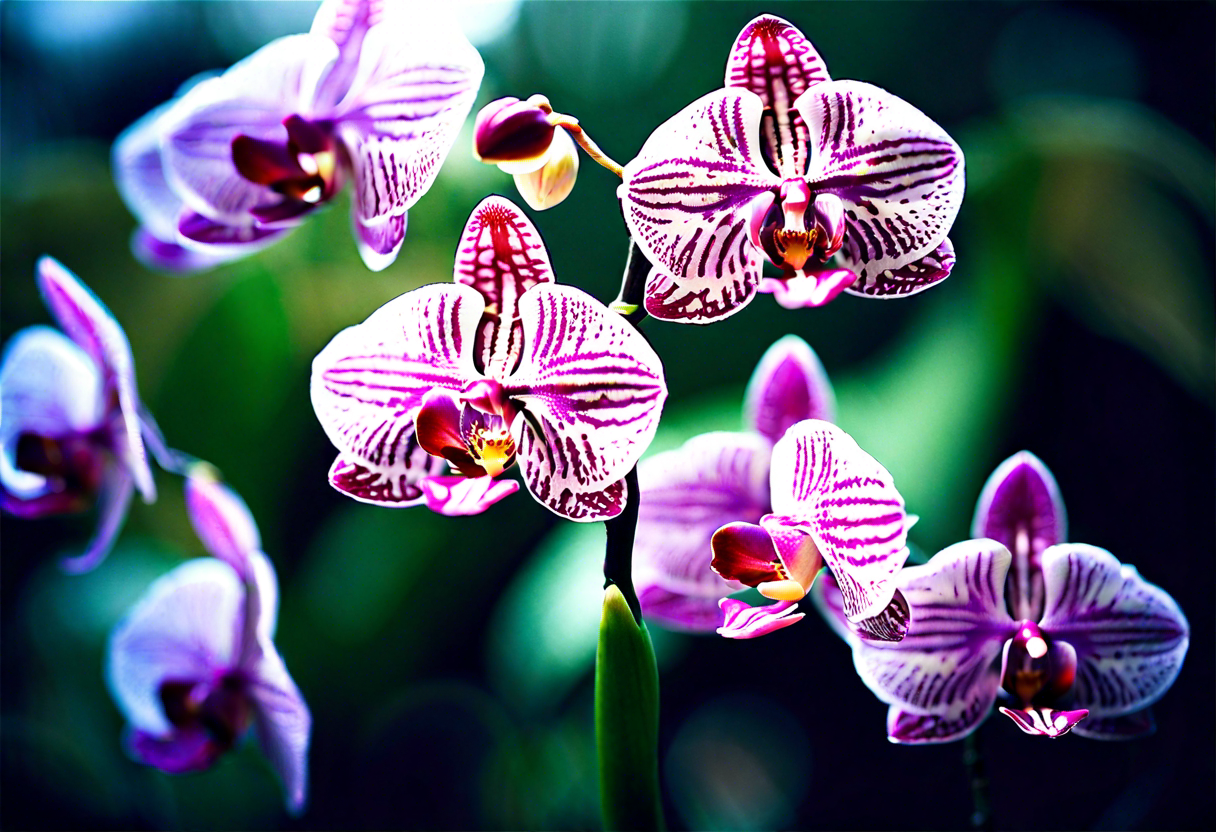Cattleya Orchids: A Comprehensive Care Guide
Cattleya orchids, often referred to as the "Queen of Orchids," are known for their stunning and vibrant blooms. To ensure these majestic orchids thrive and flourish, proper care and attention are essential. Here is a detailed guide on how to care for your Cattleya orchids:
Understanding Cattleya Orchids
Cattleya orchids are epiphytic plants native to the tropics of South America. They typically grow on trees or rocks, absorbing nutrients and moisture from the air and rain. These orchids are popular among enthusiasts for their large, showy flowers that come in a wide range of colors, shapes, and sizes.
Light Requirements
Cattleya orchids require bright, indirect light to bloom successfully. Place them near a south or east-facing window where they can receive ample sunlight without being exposed to direct rays that may cause sunburn. Ideally, they should receive around 12-14 hours of light daily.
Temperature and Humidity Levels
Maintaining the right temperature and humidity levels is crucial for Cattleya orchids. They thrive in temperatures between 70-85°F (21-29°C) during the day and slightly cooler temperatures at night. Additionally, they prefer humidity levels of around 50-70%. To increase humidity, place a humidifier near the plants or use a humidity tray.
Watering and Fertilizing
Proper watering is essential for Cattleya orchids. Water them thoroughly once a week during the growing season, allowing excess water to drain out completely. Reduce watering frequency during the dormant period. Fertilize your orchids every 2-3 weeks with a balanced orchid fertilizer to promote healthy growth and blooming.
Common Pests and Diseases
Keep an eye out for common pests such as aphids, mealybugs, and spider mites, which can attack Cattleya orchids. To prevent infestations, regularly inspect your plants and treat them with insecticidal soap if necessary. Additionally, watch for signs of fungal or bacterial infections, such as yellowing leaves or black spots, and address them promptly.
By following these care tips, you can enjoy the beauty of Cattleya orchids in your home or garden. With proper attention to their lighting, temperature, watering, and pest control needs, you can help your Cattleya orchids thrive and bloom vibrantly throughout the year.
Lighting Requirements for Cattleya Orchids
The lighting requirements for Cattleya orchids are crucial for their growth and bloom. These orchids are known for needing bright, indirect light to thrive. They generally require about 12-14 hours of light each day. In nature, Cattleyas are often found growing on trees, where they receive filtered sunlight. When grown indoors, replicating this natural light condition is essential.
Ideally, place your Cattleya orchid near a south or east-facing window where it can receive bright, indirect sunlight. Direct sunlight can cause leaf burn, so it’s important to provide some form of protection, such as sheer curtains or blinds. If a south or east-facing window is not available, artificial grow lights specifically designed for orchids can be used to supplement natural light.
During the winter months when daylight hours are shorter, using grow lights becomes even more important. Keep in mind that the intensity of light decreases as you move farther away from the source, so make sure to adjust the distance between the orchid and the light accordingly.
Monitoring the color of the leaves is a good way to assess if your Cattleya orchid is receiving adequate light. Healthy leaves should be a medium apple green color. Dark green leaves may indicate that the orchid is not receiving enough light, while yellow or red leaves could be a sign of too much light. Adjust the orchid’s light exposure accordingly to ensure optimal growth and flowering.
Providing the right amount of light is essential for the health and blooming of Cattleya orchids. By following these lighting requirements and making necessary adjustments, you can help your orchid thrive and display its stunning blooms for years to come.
Ideal Temperature and Humidity Levels for Cattleya Orchids
Cattleya orchids, known as the "Queen of Orchids," are prized for their vibrant blooms and unique beauty. To ensure these stunning flowers thrive, it is crucial to provide them with the ideal temperature and humidity levels. Cattleya orchids are native to tropical and subtropical regions, so replicating their natural habitat conditions is essential for their well-being.
The ideal temperature range for Cattleya orchids is between 70 to 85 degrees Fahrenheit (21-29 degrees Celsius) during the day and not below 55 degrees Fahrenheit (13 degrees Celsius) at night. Providing a moderate temperature fluctuation between day and night mimics their natural environment and promotes healthy growth. Avoid exposing Cattleya orchids to sudden temperature fluctuations or drafts, as this can stress the plants and lead to issues like bud blast.
In terms of humidity, Cattleya orchids prefer humidity levels ranging from 50% to 70%. To maintain adequate humidity levels, consider using a humidifier, a humidity tray filled with water and pebbles, or placing the orchids near a humid area like a bathroom. Regular misting can also help increase humidity, especially in dry climates or during the winter months when indoor air tends to be drier.
It’s important to note that proper air circulation is essential for Cattleya orchids, as stagnant air can promote the development of fungal diseases. Providing good air circulation can be achieved by using a fan on a low setting or placing the orchids in a well-ventilated area. However, be cautious not to place the orchids in a drafty location, as this can lead to temperature stress.
Monitoring temperature and humidity levels is key to the successful cultivation of Cattleya orchids. Investing in a reliable thermometer and hygrometer can help you track these conditions accurately. Additionally, adjusting the settings on heating or cooling systems in your home can help create a more favorable environment for your orchids.
By ensuring that your Cattleya orchids are exposed to the ideal temperature and humidity levels, you are setting the stage for healthy growth and prolific blooming. With proper care and attention to these crucial factors, you can enjoy the beauty of these majestic orchids for years to come.
Watering and Fertilizing Cattleya Orchids Properly
Cattleya orchids, known as the "Queen of Orchids," are prized for their vibrant and fragrant flowers. To ensure these majestic plants thrive and bloom successfully, it is crucial to understand how to properly water and fertilize them. Here is a comprehensive guide on watering and fertilizing Cattleya orchids:
Watering:
Proper watering is essential for Cattleya orchids as they are susceptible to root rot if their growing medium remains excessively moist. It is recommended to water Cattleyas early in the day, allowing ample time for their roots to dry before nightfall. The frequency of watering largely depends on environmental conditions such as temperature, humidity, and the type of potting medium used. As a general rule of thumb, Cattleyas should be watered when their growing medium approaches dryness.
When watering, it is advisable to use room-temperature water to prevent shock to the orchid’s roots. Water the orchid thoroughly, allowing excess water to drain away completely. Avoid leaving the orchid standing in a saucer of water as this can lead to root suffocation. Additionally, consider the seasonal variations in watering needs, as Cattleyas may require more frequent watering during their active growth phase.
Fertilizing:
Proper fertilization is key to supporting the growth and blooming potential of Cattleya orchids. During the active growing season, which typically spans from spring to early fall, it is recommended to fertilize Cattleyas bi-weekly to monthly. A balanced orchid fertilizer with an N-P-K ratio of 20-20-20 or 30-10-10 can be used to provide essential nutrients.
Before fertilizing, ensure that the orchid is adequately watered to prevent fertilizer burn. It is advisable to dilute the fertilizer to half or a quarter of the recommended strength to avoid salt buildup in the growing medium. Overfertilizing can cause salts to accumulate, leading to root damage and diminished plant health. During the dormant period in winter, reduce the frequency of fertilization to once every 6-8 weeks to allow the orchid to rest.
Mastering the art of watering and fertilizing Cattleya orchids is crucial for their overall health and vitality. By adhering to proper watering practices and providing balanced fertilization, you can enjoy a stunning display of blooms from these majestic orchids throughout the year.
Common Pests and Diseases Affecting Cattleya Orchids
Cattleya orchids, also known as the "Queen of Orchids," are prized for their stunning blooms and unique beauty. However, like any other plant, they are susceptible to a range of pests and diseases that can affect their health and vitality. In order to keep your Cattleya orchids thriving, it is essential to be aware of the common issues that may arise and how to address them effectively.
Pests:
-
Aphids: These tiny insects feed on the sap of the orchid plant, causing leaves to curl and distort. To combat aphids, gently wash the leaves with a diluted soapy solution or neem oil.
-
Spider Mites: These pests are common in dry conditions and can cause stippling on leaves. Increase humidity around your orchids and use insecticidal soap to control their population.
-
Mealybugs: Found in clusters along stems and leaf joints, mealybugs excrete a sticky substance that can attract ants. Remove them with a cotton swab dipped in alcohol.
-
Slugs and Snails: These creatures can feast on orchid leaves and blooms. Remove them by hand or use pet-safe slug bait to deter them.
-
Thrips: Thrips are tiny insects that suck sap from orchid tissues, causing silvery streaks on leaves. Introduce predatory insects like lacewings or release nematodes to control thrip populations.
Diseases:
-
Root Rot: Overwatering can lead to root rot, causing the roots to become mushy and brown. Allow the orchid’s roots to dry out between waterings and repot in fresh media if necessary.
-
Bacterial Soft Rot: This disease presents as water-soaked, mushy black spots on leaves and pseudobulbs. Remove infected tissue, improve air circulation, and avoid overhead watering.
-
Fungal Leaf Spots: Circular, water-soaked spots on leaves are indicative of fungal infections. Remove affected leaves and improve air circulation to prevent further spread.
-
Viral Infections: Orchids can contract viruses, leading to mottled leaves and stunted growth. Unfortunately, there is no cure for viral infections, so infected plants should be isolated and disposed of to prevent spread.
-
Botrytis: This fungal disease causes brown spots on flowers and foliage. Remove affected tissue promptly and ensure good air circulation to prevent its spread.
By staying vigilant and addressing pest and disease issues promptly, you can ensure that your Cattleya orchids remain healthy and vibrant, rewarding you with their exquisite blooms for years to come.
Conclusion
To ensure the optimal growth and blooming of Cattleya orchids, it is crucial to understand and implement a comprehensive care guide tailored to their specific needs. These stunning plants, known as the "Queen of Orchids," require special attention to lighting, temperature, humidity, watering, fertilizing, as well as protection against pests and diseases.
When it comes to lighting requirements for Cattleya orchids, providing them with bright, indirect light is essential. Too much direct sunlight can scorch their leaves, while insufficient light can result in poor blooming. Finding the right balance and adjusting their exposure according to the seasons can help maintain their health and vigor.
Maintaining ideal temperature and humidity levels is equally vital for the well-being of Cattleya orchids. These plants thrive in temperatures between 65-75°F during the day and slightly cooler at night. Additionally, they prefer humidity levels of around 50-70% to mimic their natural tropical habitat.
Proper watering and fertilizing practices play a significant role in keeping Cattleya orchids healthy and vibrant. Providing them with a well-draining potting mix and watering only when the top layer feels dry to the touch can prevent root rot and other moisture-related issues. Fertilizing with a balanced orchid fertilizer at half-strength every 2-3 weeks during the growing season can promote strong growth and beautiful blooms.
Despite their resilience, Cattleya orchids are susceptible to certain pests and diseases that can affect their overall health. Keeping an eye out for common issues such as aphids, mealybugs, scale, and rot is crucial for early detection and control. Regular inspections and prompt treatment using organic methods or gentle insecticides can help safeguard your orchids from potential threats.
Mastering the art of caring for Cattleya orchids requires a combination of knowledge, attention to detail, and a genuine passion for these magnificent plants. By following the guidelines outlined in this comprehensive care guide, you can create an environment that allows your Cattleya orchids to flourish and showcase their unparalleled beauty year after year. With the right balance of light, temperature, humidity, watering, fertilizing, and vigilant pest and disease management, you can cultivate a stunning collection of Cattleya orchids that will truly reign as the queens of your orchid garden.


